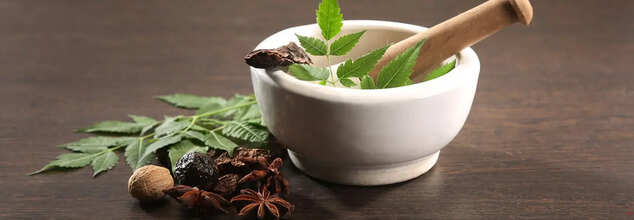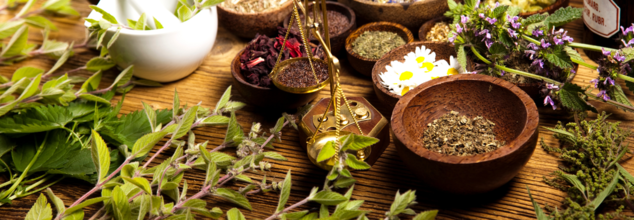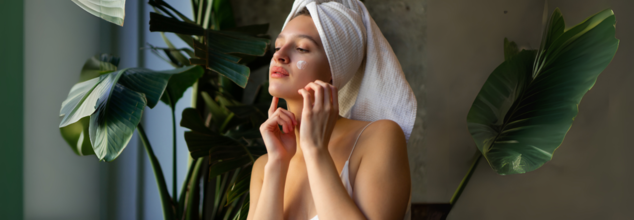- Health Conditions A-Z
- Health & Wellness
- Nutrition
- Fitness
- Health News
- Ayurveda
- Videos
- Medicine A-Z
- Parenting
- Web Stories
These 3 Ayurvedic Herbs Can Help You Protect Your Skin From Heat

Credit: Canva
Tanning, dryness, and sunburn—when summer hits hard, your skin often takes the biggest blow. Whether it's sunburn from a day outdoors or stubborn tanning after just a few minutes in the sun, the effects can linger and frustrate. Most people rush to grab chemical-based lotions and quick-fix products. While these might offer temporary relief, they often come at the cost of long-term skin health and may even cause damage over time.
But what if the solution isn’t on the store shelves but in your kitchen? Ayurveda has long relied on herbs that calm the body, balance the Pitta dosha (which governs heat), and protect the skin from sun damage, inflammation, and dryness. Pitta is described as hot, sharp, oily, and penetrating. When fiery Pitta flares up–we burn up and burn out. That's why reducing body heat with Ayurveda starts with reducing Pitta dosha.
Signs of Pitta Imbalance
Pitta heat manifests in many ways, including:
- Inflammation
- Skin conditions
- Migraines
- Acid reflux
- Loose stools
- Nausea
- Constipation
- Body odor
- Excessive sweating
- Unpleasant menstrual cycles
- Burnout and fatigue
- Mental heat (think short-fuses and irritability)
3 Ayurvedic Herbs Hold Solution To These Problems
1. Liquorice (Mulethi): The Brightening HealerStruggling with sunburn and dark spots? Liquorice, or Mulethi, is your skin’s natural ally against harsh summer damage. This powerful Ayurvedic herb is known for its cooling, anti-inflammatory, and antioxidant properties. It helps balance the Pitta dosha, which governs heat in the body and is often responsible for summer skin issues like tanning, rashes, and irritation.
Liquorice works on multiple levels—topically, it soothes inflamed skin and fades pigmentation, while internally, it supports hormonal balance and detoxification. The presence of glabridin, a natural compound found in liquorice root, helps inhibit the enzyme that causes skin darkening, making it highly effective for lightening sun-induced spots and hyperpigmentation.
You can apply liquorice powder mixed with rose water as a face mask or sip it as a herbal infusion. Regular use not only restores your skin’s glow but also builds resistance against further sun damage, making it a must-have for your summer skincare arsenal.
2. Sariva (Anantmool): The Detoxifying Soother
Sariva, also known as Anantmool, is a revered herb in Ayurveda for its profound detoxifying, cooling, and rejuvenating effects on the body and skin. Especially effective in summer, Sariva helps purify the blood, calm inflammation, and cool down the internal system, which is crucial when Pitta dosha is aggravated by heat and humidity.
This herb is a saviour for those suffering from acne, rashes, or frequent skin breakouts, as it helps eliminate toxins from the bloodstream that often manifest as skin problems. Sariva also has a naturally sweet and earthy aroma that promotes calmness and relaxation—benefits that extend to the skin by reducing stress-induced flare-ups.
You can consume Sariva in powdered or decoction form or apply it as a paste on affected areas. It also pairs well with other herbs like neem and turmeric for enhanced results. With regular use, it leaves your skin noticeably clearer, calmer, and visibly refreshed.
3. Vetiver (Ushira): Nature’s Skin Cooler
Vetiver, or Ushira, is a hidden gem in Ayurvedic skincare and an excellent remedy for heat-related skin problems. Often referred to as "khus" in India, Vetiver is packed with cooling, anti-inflammatory, and hydrating properties that make it ideal for summer wellness. It helps reduce excessive body heat, soothes sunburn, and fights skin irritation caused by overexposure to the sun.
Vetiver is also a natural astringent that tightens the skin and prevents breakouts, while its hydrating effect tackles summer dryness and flakiness. Whether used in the form of face mists, bath soaks, or herbal teas, Vetiver provides a calming and grounding effect on both skin and mind.
Its essential oil is often used in aromatherapy to ease anxiety and balance emotional heat, which indirectly supports skin health. Integrating Vetiver into your daily routine helps maintain your body’s internal cool, making your skin feel nourished, balanced, and visibly rejuvenated even in peak summer.
The King Of Ayurvedic Medicine That Claims To 'Cure-All And Prevent-All' Illnesses—What Is Haritaki & Its Benefits?

(Credit-Canva)
Ayurvedic remedies have been part of decades old medicinal practices. Many ingredients that are a regular part of our diet now, used to be important medicines that we added to our diets to ensure long-term health. One such herb is Myrobalan or haritaki. Ayurveda has many herbs that have been used for decades for medicinal purposes.
It's a very important herb in Indian traditional medicines. The fruit is small and oval shaped. Haritaki fruits are usually picked when they're green, then dried until they turn brown or black, and then ground into powder for medicine. How strong it depends on where it was picked, its color, and its shape. It's also known as harad or kayakalpa, which means something that makes your body young again and balances its energy. People often call it a "life-giving" herb.
Haritaki's Health Benefits
Ayurveda values haritaki a lot because it helps with many health issues. It helps balance all the body's parts, especially "ether" and "air," which are thought to cause most sicknesses. This herb is full of important things like vitamin C, vitamin K, magnesium, and good chemicals called antioxidants. Ayurvedic doctors use haritaki to treat many health problems, both short-term and long-term. It's also one of the three ingredients in a famous Ayurvedic mix called triphala.
You can take haritaki in different ways for different needs. For example, you can mix it with butter to help with "air" imbalances, or with a little sugar for "fire" and "heat" imbalances. For "water" and "earth" imbalances, you can take it with a little salt. Always talk to a knowledgeable herbalist before adding any new herb to your health routine.
Studies suggest that different types of haritaki fruit are used for specific health problems. Research shows haritaki is good for things like coughs, constipation, indigestion, cleaning your body, weight loss, skin problems, and boosting your body's systems, immunity, fertility, and sex drive. It also helps with regular bowel movements and keeping your body's parts healthy. The fruit has substances that can fight cancer, fungi, bacteria, and diabetes, and also act as antioxidants. These properties also help your heart, heal wounds, and aid digestion. Older research also suggests it helps with hemorrhoids, but more studies are needed.
Haritaki's Beauty Benefits for Skin, Hair, and Nails
Because haritaki helps make cells new again and has antioxidants, people believe it can make your skin, hair, and nails healthier.
Skin
Research suggests haritaki can help with many skin problems. For everyday skin health, you can make a paste by mixing haritaki powder with water or rose water. If it feels too dry, just add a few drops of oil. A paste made with the powder, butter, and water has even been shown to help with cracked feet.Hair
Old Ayurvedic books mention using haritaki powder in hair dyes. These mixes have been used for many years without known bad effects. Research shows that haritaki not only makes hair darker but also makes it softer.
Nails
A study from 2019 suggested that haritaki's ability to fight germs might help with nail infections. But, more good research is needed to be sure.
Safety and What to Watch For
Even though haritaki is generally safe, some people should not take it. Do not take haritaki if you are pregnant, have recently given blood, feel very tired, have diarrhea, are dehydrated, or are taking medicines for high blood sugar (like insulin). Even if you don't have these conditions, always talk to a knowledgeable herbalist before using haritaki.
Seasonal Sickness And Changing Weather: Ayurvedic Remedies For Cold, Cough And Sore Throat

(Credit-Canva)
Ayurveda is one of the world's oldest medical systems. Its origins go back over 3,000 years, found in ancient Indian writings called the Vedas. Today, it's still widely used as an alternative medicine. Ayurveda looks at health in a complete way, believing our bodies are made of five elements: air, space, fire, water, and earth. These elements form three parts called "doshas." When these doshas are out of balance, that's when illness is thought to happen.
While there isn't much scientific proof that Ayurveda directly cures common sicknesses like colds and flu, some of its herbal remedies might help you feel better and manage symptoms.
Ayurvedic Remedies to Know During Seasonal Change
For a Dry Cough (No Mucus)
In Ayurveda, tulsi is often called the "queen of herbs." It's a popular choice for dry coughs. Some small studies suggest tulsi might help loosen phlegm and improve coughs caused by allergies, asthma, or lung problems. One older study even showed it might help asthma patients breathe better. Tulsi is generally safe and might also help keep your blood sugar, blood pressure, and cholesterol levels healthy.
For a Wet Cough (with Phlegm)
Ginger is a very common herb in Ayurveda. It has properties that can fight off bad stuff in your body and reduce swelling. Early studies on human throat cells suggest that parts of ginger might relax your throat muscles, which could ease coughing. More research is needed to be sure if ginger helps with cold or flu coughs.
For Cough and Sore Throat
Licorice Root is a herb that contains things that can help reduce swelling and pain. Studies have shown that licorice applied directly can help with sore throats after surgery. One study found that gargling with licorice extract greatly reduced sore throats after an operation. While we need more studies for sore throats from colds or flu, it looks promising.
For Cough and Fever
Sudarshana Powder is a traditional Ayurvedic powder is often used to treat fevers. It's a bitter mix of 53 different herbs. It might help with fever that comes with not wanting to eat, feeling tired, sick to your stomach, or having an upset stomach. But more research is needed to know how well it truly works.
For General Cough and Cold
Garlic is believed to have properties that fight germs and viruses, which might help you avoid getting a cold. One small study found that people who took an active ingredient in garlic (allicin) had fewer colds. However, more research is needed to be certain about garlic's benefits for colds.
Other Helpful Home Remedies for Cough and Cold
Here are some other common home remedies that can help with cough and cold symptoms:
Honey Tea: Mix about 2 teaspoons of honey with warm water or tea.
Saltwater Gargle: Mix 1/4 to 1/2 teaspoon of salt in 8 ounces of warm water and gargle. This helps loosen mucus in your throat.
Steam: Breathing in steam can help clear mucus from your lungs. You can do this by filling a bowl with hot water and leaning over it (carefully!) or by taking a warm bath or shower.
Bromelain: This is an enzyme found in pineapple. Eating pineapple or taking a bromelain supplement might help break up mucus in your throat.
Peppermint: Peppermint can soothe your throat and help break down mucus. You can drink peppermint tea or add peppermint oil to a steamy bath.
Ayurvedic Based Skin Care Tips To Rejuvenate Your Skin Health

(Credit-Canva)
Skin care has become all the rage recently. There are many products and skin care routine tutorials that can help you find what products you should use and how you can go about building your own skin care routine. However, an issue you may face with these products and routines is how expensive and inaccessible they are. There are products that may not be available to you or may be way beyond your budget. If this is an issue for you, you can try ayurvedic remedies.
Ayurvedic skincare is a beauty approach rooted in ancient Indian medicine. It involves special Ayurvedic facials, treatments for various skin problems, and natural herbal products for your skin. While there are many Ayurvedic skincare products available today, it's important to know their quality and ingredients to get the best results. Ayurvedic home remedies for skin care are also popular and are thought to work best for specific skin types and needs.
However, before you go ahead and try ayurvedic recipes, one must know what kind of skin type they have, this will help you identify what kind of skincare you need.
Skincare for Each Dosha
Vata Skin (Dry & Rough)
If you have a dominant Vata dosha, your skin tends to be dry and rough and can wrinkle easily if not kept moisturized. According to ayurveda, Vata skin has less fat and needs more moisturizing, both from the outside (creams) and inside (food). She suggests using oil-based moisturizers and eating warming spices like ginger. The herb ashwagandha can also help reduce dryness when used in a face mask.
Pitta Skin (Oily & Prone to Breakouts)
People with high Pitta often have oily skin that might be prone to acne and redness (rosacea). Experts advise using cooling ingredients like aloe vera, turmeric (which helps with swelling), and sandalwood (which reduces pimples and redness) for this skin type.
Kapha Skin (Cold, Oily & Congested)
Kapha skin is typically cold and oily, and it might be prone to pimples, whiteheads, and puffiness. Experts recommend dry brushing to clear blockages, boost circulation, and exfoliate. They also suggests avoiding oil-based creams and using face masks regularly.
Easy Homemade Face Mask Recipes
Many Indian homes already have the ingredients for traditional face masks in the kitchen. Chickpea flour is a common base. You can mix it with a pinch of turmeric and milk, lime juice, or rose water to make a classic paste. Remember, Ayurveda teaches that different skin types need different care. If you're unsure about any ingredients in a DIY mask, it's always best to ask a medical professional.
Vata Face Mask (for dry skin)
Mix 1 tablespoon chickpea flour, a pinch of turmeric, and 1/4 cup rose water, yogurt, or cold milk to form a paste. Apply for 10-15 minutes (or until almost dry), then wash with lukewarm water and apply an oil-based moisturizer like sesame oil.
Pitta Face Mask (for oily, irritated skin)
Dab rose water on your skin to cleanse. Then apply 1/4 cup pure aloe vera gel for 10-15 minutes. Wash with lukewarm water and use a gentle moisturizer (like one with geranium oil). Repeat 2-3 times a week.
Kapha Face Mask (for oily, congested skin)
Mix 1 teaspoon honey with a pinch of turmeric. Apply for 10 minutes and wash with lukewarm water. Or mix Multani mitti (fuller’s earth) with water to make a paste. Apply for 10-15 minutes and wash with lukewarm water.
Face Mask for All Skin Types
Mix 2 tablespoons fine oat flour, 2 teaspoons almond flour, a pinch of turmeric, and 2-5 drops of an oil of your choice. Apply a thick layer for 15 minutes, then wash with lukewarm water. This paste can also be used for your whole body.
© 2024 Bennett, Coleman & Company Limited

